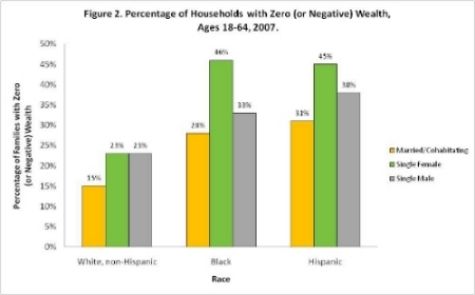Accordingly to an article entitled, “More Women Are bringing Home the Bacon…, ” heralding women’s gains in pay equity, a recent Pew study revealed that an impressive number of married breadwinner moms reflects society’s increasing opportunities for women, while the median income for the growing population of single mother households is $23,000 — just 28 percent of the income of one in which the female breadwinner is married, and less than half the median household income in America.
So What Else Is New?
The wage gap between women’s and men’s individual wages is the most standard indicator used to define women’s march toward equality. In recent studies of the gender wage gap, women make between 76 to 78 cents for every dollar made by men and most literature is optimistic that the gap will disappear or even reverse in the near future. The gender wealth gap, however, another measure of gender inequality which measures the total wealth or net worth a woman has accumulated over time, shows that women have, on average, only 6% to 36% of the wealth owned by men and that the gap is growing.

source:http://www.cunapfi.org/download/198_Women_of_Color_Wealth_Future_Spring_2010.pdf
The stark difference between these two measures suggests two things about statistics:1) statistics on the same subject can fluctuation wildly depending on what is being measured and the methodology used and 2) One of the main functions of statistics is not to measure the reality, but as a propaganda tool to reinforce the ideology of the dominant culture.
The problem with using the wage gap . As a measure of inequality, the gender wage gap only measures an individual’s income growth in the market place and does not take into account either the worth of women’s unpaid social labor in the home(outside the marketplace) or how this unpaid labor structurally effects women’s position in the market place over time.
Because of its narrow parameter, much of the analysis of what the wage gap means in terms of the overall inequality of men versus women is merely a guess that allows for a lot of unverifiable interpretations. For example, the recent Pew study echoes a demographic study that hit the New York Times a couple of years ago that showed a narrowing of the wage gap, suggesting women’s wages were even surpassing men’s in some cases, especially in major cities.
The cause of women’s increased equality, the researcher suggested, was due to increases in women’s higher educational status and increased “feminist consciousness.” In fact, a closer analysis showed that the close in the wage gap was due to the outsourcing of well paying union manufacturing jobs which had been held by men due to a sex segregated workforce. By focusing on city populations where people of color form a larger part of the database, the lower gap also reflected the fact that the wage gap is generally lower between women and men of color since men of color generally make significantly less than white men due to racism.


Recent Comments